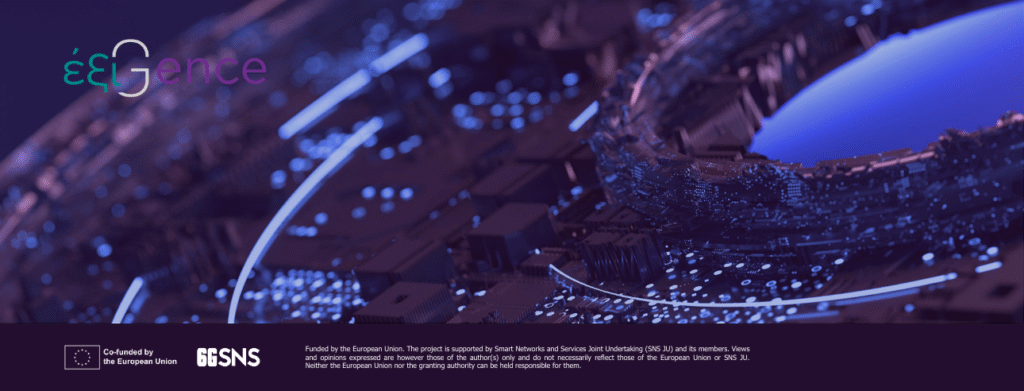
Why do metrics matter?
By addressing the measurements, as one of EXIGENCE key pillars (measure, optimise, incentivise), EXIGENCE metrics contribute to defining how to quantify the Energy Consumption (EC) and carbon footprint of Information and Communication Technologies (ICT) services, and thereby enable using EC and carbon footprint quantities for further optimisation, planning, and incentivisation purposes. EXIGENCE initial thoughts and activities on metrics have been already introduced in Development of EXIGENCE Energy Consumption, Efficiency, and Carbon Footprint Metrics blogpost, while our latest observations, findings and achievements are presented here and detailed in deliverable D2.1 Metrics for end-to-end energy consumption and efficiency metering.
EXIGENCE advocates energy consumption and carbon emissions metering at service level, i.e., along service’s complete end-to-end path, which typically spans across multiple domains, or, in other words, multiple domains are involved in service provisioning. The service level approach also seems necessary due to typical practices found in nowadays ICT networks, e.g., over-the-top (OTT) services, virtual network operators, operations in multitenancy cloud environments, etc. Therefore, if the goal is metering of energy consumption and carbon emission for each user (being either end customer or business user), service level approach to energy consumption and carbon emission metering is a must. As mentioned above, such approach further allows for eco-efficient optimisations, short- and long-term planning, as well as for incentivisation on service and user level.
Filling the Gap
While looking at implementing such an approach utilising State-of-The-Art standards, one may observe that the current SoTA focuses on energy consumption of network sites as a whole, and to physical components (i.e., networking and computing components). Additionally, the standardisation recognises virtualisation (such as Network Function Virtualisation – NFV and Software-Defined Networking – SDN) as key network evolution strategies. However, metrics for measuring NFV and SDN energy consumption and suitable measurement methods are yet not adequately addressed. The most recent 3GPP standardisation proposals, such as e.g. 3GPP TR 22.882, suggests “providing information exposure on systematic energy consumption or level of energy efficiency to vertical customers,” while the same document also reports that “there is currently no means for the 5G network to determine the per subscriber or per network slice service flow energy consumption”. Therefore, EXIGENCE metrics aim to fill the gap between SoTA and EXIGENCE use case requirements. Notably, the proposed EXIGENCE metrics allow for distinction of energy consumed by system or service itself (i.e., when there are no user activities), and, on the other side, EC explicitly related to the user activities. One of main challenges observed in literature so far is the dilemma of how to divide system and service own EC among users who are consuming the service (and the system), i.e., in order to fairly split costs among the users, through EXIGENCE, a different approach can be proposed – own EC of the system and the service may be attributed solely to its respective operator/owner, while additional energy, consumed as a consequence of users’ activities, should be therefore contributed to individual user consuming a service.
Development of Metrics
EXIGENCE uses cases illustrate how innovative technologies and services can be refined to target reduction of EC and promote carbon neutrality. Addressing use cases’ requirements and following service level approach, several metrics handling EC and carbon footprint from multiple perspectives are needed. Although such a diverse set of requirements may lead to the development of highly specialised metrics, the objective of EXIGENCE is to define a core set of fundamental metrics that can be flexibly combined to facilitate the full range of use cases.
The idea of defining a set of fundamental metrics follows a basic principle of designing a service – starting with basic/atomic components, stacking and linking them together to build a final product. This, however, includes design, implementation and integration of software and hardware components, identification of suitable site(s) for operating the service, selecting and managing power supply, etc. EXIGENCE principle therefore strives at ability to measure EC of every component contributing to the service operation. Given the fact that services nowadays typically run in virtual, multitenancy environments, as well as considering other practices such as sharing radio and transport network capabilities, there is a practical challenge of extracting true EC for each service (or component) running in such an environment. As it is not possible for all cases to overcome this challenge by measuring, estimation methods need to be employed in same cases. However, as mentioned before, EXIGENCE is committed to favour measurements over estimations as much as possible. Even so, if one wants, e.g., to evaluate EC of a single user consuming service, it is so far not possible to avoid estimations.
Following the above paradigm, EXIGENCE proposes eight metrics related to EC, focusing on (in)direct energy consumption of various components in ‘(near) real time’ i.e. during service’s run time. Further, EXIGENCE introduces a metric for capturing the renewable energy portion, which is also needed for four Carbon Footprint metrics proposed. Additionally, EXIGENCE proposes a metric aiming at quantifying energy consumption relative to a zero load (i.e. when no ICT service is ongoing), and a metric quantifying an estimated change in energy consumption when ongoing ICT service would be adjusted, resulting in (an estimated) change of the current load.
EC set of metrics is based on two canonical metrics:
- a metric addressing EC of an (atomic) software process which is the process (e.g., executable/binary) whose EC can be measured in practice and would typically, but not limited to, run in a virtual environment; this atomic process is perceived as basic building block of a service and can be in practice also implemented as a container or virtual machine,
- similarly, EXIGENCE addresses EC of hardware environment by defining a canonical metric for EC of various HW devices (e.g., UE, server, storage device, radio equipment, switch, router, etc.).
Canonical metrics are utilised in derived metrics defining EC of a software component (defined as a sum of ECs of atomic process it is composed of), EC of an end-to-end service (defined as a sum of ECs of all components involved in the service provisioning), EC of virtualised environment (accounting for total energy consumption of all software components/processes which are necessary for the virtual environment to exist and operate, is therefore proposed), residual EC of a service (evaluating common EC required for the services to run), and EC of a single user end-to-end session metric aiming at identifying EC of a single user within total EC of a service (the main challenge of this metric is accurate evaluation of the single user session EC fraction within the EC of a service where the particular service serves multiple users).
As mentioned before, EC impacts Carbon Footprint, therefore EXIGENCE Carbon Footprint metrics are based on EC metrics and scaled with a metric capturing the renewable energy portion. Carbon footprint metrics thus present energy consumption as a carbon footprint, which is the total amount of greenhouse gases (including carbon dioxide and methane) that are generated by a specific activity within the ecosystem, i.e.: carbon footprint of hardware device usage, carbon footprint of software component, carbon footprint of a complete end-to-end service chain, and carbon footprint of a single user’s end-to-end traffic flow. As in case of EC metrics, Carbon Footprint metrics span across multiple domains.
On Energy Efficiency
Important use of EC measurements is also to calculate the energy efficiency of a system and possibly compare the energy efficiency between systems or between two different states of the same system. In the most basic sense, energy efficiency is the quotient between the output and input of energy in a given system. This basic definition on energy efficiency is not suitable for ICT systems, because if we look at ICT systems they do not only transform one energy form into another but rather consume energy to facilitate a certain communication link or provide a service. Therefore, the basic energy efficiency definition needs to be transposed into more useful definition when applied in the ICT domain. For example, the European Parliament has given a slightly more specific definition in directive (EU) 2023/1791 that is more applicable to ICT systems:
(8) ‘energy efficiency’ means the ratio of output of performance, service, goods or energy to input of energy.
Within the domain of communication networks, performance is the most applicable output. The well-known performance metrics used in communication networks are throughput, latency, packet loss, jitter, wireless coverage, etc. Depending on the specific ICT services supported by the network, the most applicable performance metric can vary, e.g., both ETSI and 3GPP have recognised this fact and introduced energy efficiency metrics based on e.g. data volume, average latency, etc. However, although this makes it impractical to define a unified energy efficiency metric, it is useful to define a general energy efficiency in the different communication networks domains as , and basically follow the current definitions in the state-of-the-art (SoTA). Consequently, the EE comparisons can be made with taking several considerations into account and accustomed to the specific situation/scenario at hand. These EE comparisons can be used either for monitoring or any optimisation/coordination actions on the network. The numerator, however, is broadly specified and must be replaced with the particular performance metric relevant for the given situation/scenario. This may depend on technical service requirements, operator policies, regulations or other aspects. Only energy efficiency comparisons with the same performance measurements on the same system make sense, and all other cases cannot be directly compared.
The Bottom Line
Dealing with EC, Carbon Footprint, and EE at the service level is not yet widely adopted in SoTA, therefore EXIGENCE project strives at pushing the boundaries of this particular field. It proposes energy metering at the most granular level, i.e., targeting the smallest SW and HW components where measurement is feasible. Building on this, EC and Carbon Footprint can be aggregated to evaluate energy related parameters of complete services, individual user sessions, virtualized environments, HW devices, etc.
As relevant metrics are of key importance for developing measurement methods and ultimately for supporting eco-efficient optimisations, short- and long-term planning, and incentivisation on service and user level, EXIGENCE further research, development, implementation and evaluation activities will consider every possibility for potential metrics improvement, so, stay tuned.
Read EXIGENCE D2.1 – Metrics for Energy Consumption and Efficiency Metering: HERE
Authors

Internet Institute Ltd
Rudolf Susnik, manages research and innovation-orientef projects at Internet Institute, focusing on 5G/6G IoT, edge-cloud continuum, sustainability in ICT and ICT for sustainability. His background includes over 15 years in the ICT industry (network operators and vendors) and research/teaching experience at the University of Ljubljana, where he earned his PhD in 2007. He also actively volunteers as a firefighter.

TNO
Ljupco Jorguseski received a Dipl. Ing. degree in electrical engineering from the University Cyril and Methodius, Skopje, Republic of Macedonia in 1996, and a Ph.D. degree in 2008 from the Aalborg University, Aalborg, Denmark. From 1997 to1999 he worked as applied researcher at TU Delft, The Netherlands on the ETSI WCDMA proposal for 3G, followed by research position on wireless 3G and 4G systems at KPN Research, The Netherlands till 2003. Since 2003 he is a senior consultant on wireless access at TNO, the Dutch national institute for applied research, focusing on radio planning and (self-)optimisation of wireless networks. From 2008 he is involved as RAN and SA groups delegate in 3GPP and from 2021 he also follows O-RAN Alliance standardisation activities. He has authored and co-authored over 30 publications in conferences, journals, book chapters and patent applications.
